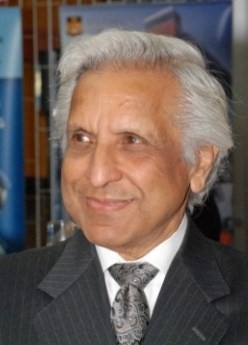Lehigh University
Office or Center Name Here
Aftab A. Mufti
Emeritus Professor, University of Manitoba, Winnipeg, Manitoba, Canada
Intelligent Sensing for Innovative Structures: Development of the New Discipline of Civionics
Thursday, October 22, 220– 4:30 pm
click here to view videoDr. Aftab A. Mufti is an Emeritus Professor of Civil Engineering at the University of Manitoba, Winnipeg, Manitoba, Canada. He is also the former Scientific Director and President of the Innovative Structures with Intelligent Sensing Canada Research Network, a Network of Centres of Excellence. His research interests include FRPs, FOSs, FEM, bridge engineering, Structural Health Monitoring (SHM). At the University of Manitoba, he introduced new research area of Civionics Engineering to monitor deteriorating infrastructure. He has authored or co-authored 5 books, plus provided chapters for 2 others, edited 9 books, and written more than 350 technical publications. Dr. Mufti is the recipient of 24 awards. He is the holder of several patents on the steel-free bridge deck concept, of which he is the principal developer. He has been involved in the writing of bridge design codes since 1992 and was the Chair of the Technical Sub-Committee on the Fibre Reinforced Structures of the Canadian Highway Bridge Design Code. He is a fellow of 9 societies. On November 2013 he was elected as a Fellow of the Royal Society of Canada (FRSC), highest scientific academy in Canada and on July 1, 2010 he was appointed as a Member of the Order of Canada, highest civilian honour bestowed on Canadian citizens. Dr. Mufti considered Dr. Fazlur R. Khan as one of our most distinguished structural engineers, which is reflected in a paper by Aftab A. Mufti and Baidar Bakht, "Fazlur Khan (1929-1982): reflections on his life and works" published in the Canadian Journal of Civil Engineering in 2001.
Intelligent Sensing for Innovative Structures: Development of the New Discipline of Civionics. Civil infrastructures are essential for modern and advanced societies. These structures are foundation of a vibrant economy and improve the quality of people’s lives. Therefore, civil engineers strive to design, construct, and maintain structures meeting the highest standards of engineering to enhance safety, durability, and functionality of such infrastructure. However, civil engineers are conservative and have been slow in adopting Structural Health Monitoring (SHM) to inspect and evaluate the infrastructures. The built infrastructures are subject to service and environmental loads. These loads reduce reliability and life cycle performance regardless of their construction quality. Structural damage due to heavy loads, fatigue, temperature, humidity, corrosion, and scour are commonly encountered especially in countries with extreme cold climate like Canada and the USA. The traditional approaches of service life assessment which mostly rely on visual inspection and human judgment are less effective in assessing the health of ageing structures. It is of utmost importance to develop inspection methods to assess the service and end of life of a structure. Through the development of the new discipline of Civionics, which integrates Civil Engineering with Electronics, Canada has monitored corrosion free innovative structures for last thirty years. This lecture presents some of the innovations that have been implemented in various infrastructure projects across Canada under the federal program called the Networks of Centres of Excellence (NCE) for Intelligent Sensing of Innovative Structures (ISIS).
